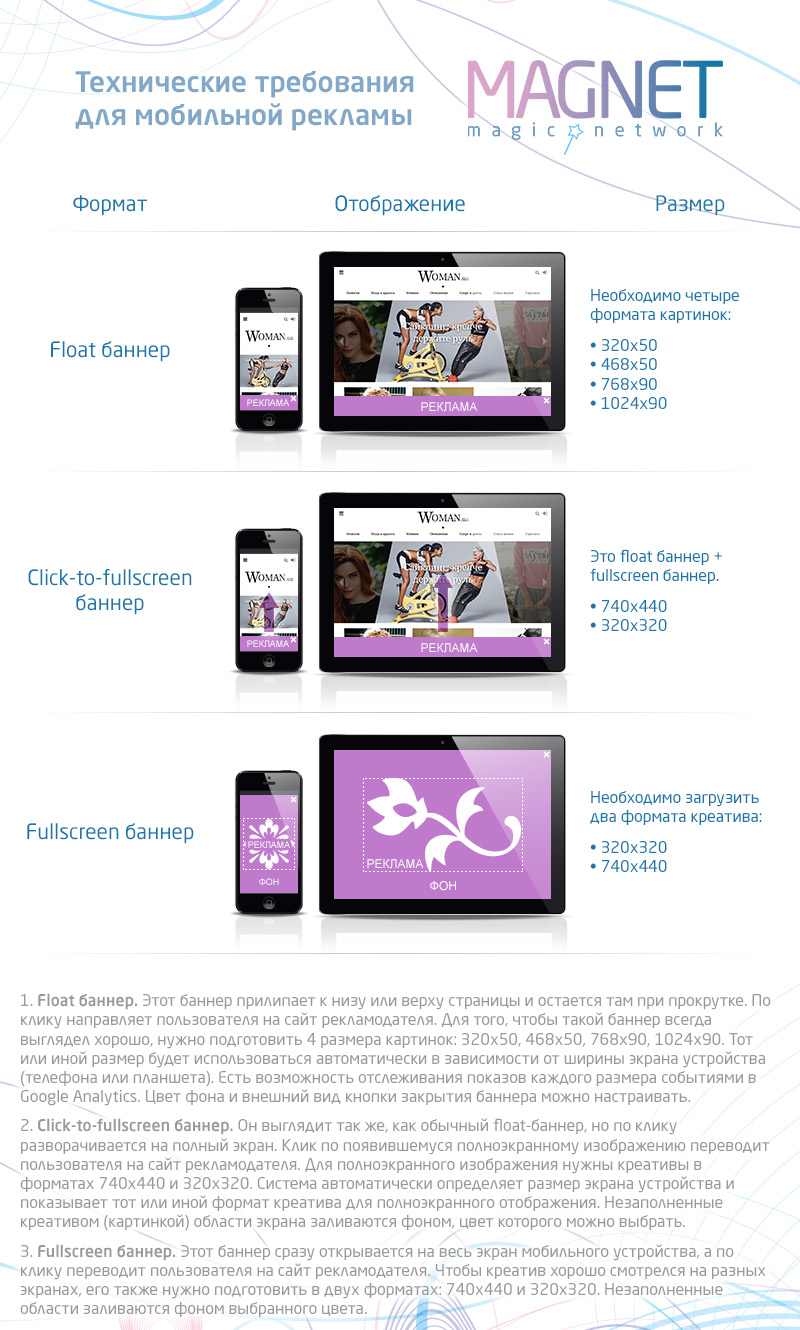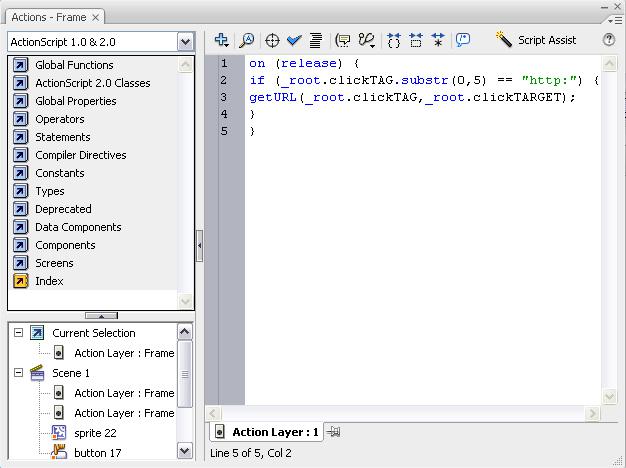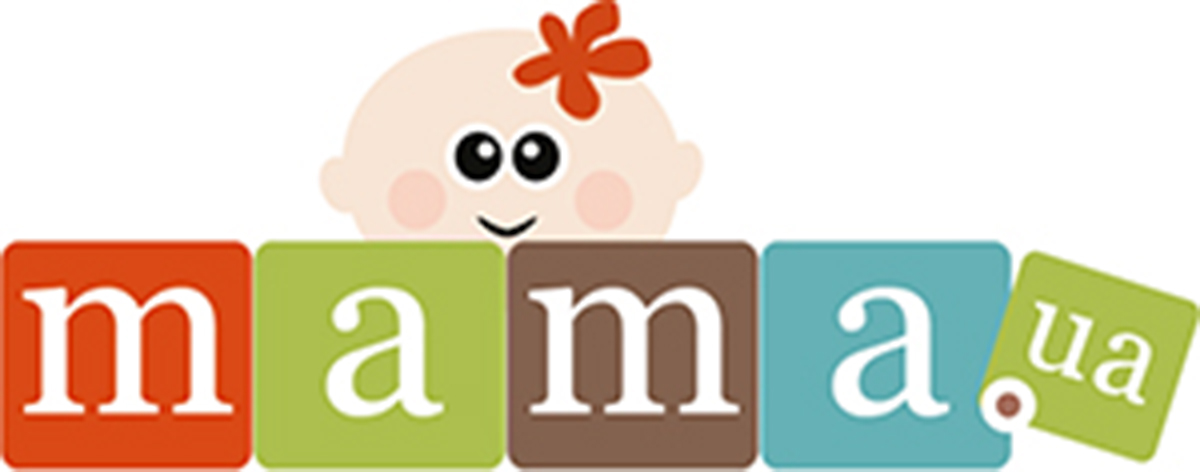Banner requirements:
- Graphic bannerBanners of GIF format (static or animated), JPG, PSD are accepted for placement. Standard banner width / height in pixels: 300×250, 300×600, 620×250, 728×90, 960×90 (Other options are possible depending on the placement). Banner size should not exceed 150 KB.
- HTML5 banner (recommended)
- Preparation of html5 banner. Prepare the HTML code for the banner. It can be any HTML code, including HTML 5, which is an HTML layout of a banner with CSS styles and JavaScript code. JavaScript and CSS should preferably be placed inside the banner’s HTML code, rather than included as separate files. However, if necessary, the use of separate files is also allowed. You can use both absolute links to files loaded into the banner (various images) and relative ones. When using relative file paths, all banner files must be in the same folder as the HTML file being prepared. Those. there should be no additional folders for images, js files or media files.
- Banner size should not exceed 500 KB.
- Accounting for a click (one) in an html5 banner. By default, clicks in an HTML banner are ignored. To account for clicks in the HTML file, you need to make changes according to this instructions: Open the HTML file with a text editor, include the creative_click.js file:
<script src="https://x.magnet.kiev.ua/tmp/creative_click.js"></script>
You don’t need to download the creative_click.js file or create it yourself. This file is hosted on magnet servers and it is enough just to include it in the prepared file.
- MPU-banner and HTML-FullScreen. To place an MPU banner, we accept a code that inserts the banner itself and displays it, for example:
<div id="adriver_banner_1191798600"></div> <script> new adriver("adriver_banner_1191798600", {sid:1, bt:52, ad:620328, pid:2530918, bid:4975350, bn:4975350}); </script>An HTML MPU banner should consist of several iframe panels and a control script script.js. In the control script, you need to implement the logical script of the banner itself. One of the scenarios: when you hover over the base 300×250 iframe panel, a second 600×250 iframe panel appears on top, which can be closed by clicking on the cross.
The requirements for the size of the base iframe-panel correspond to the requirements for the size of the banner placed in this position. The sizes and behavior of banner MPU elements should not lead to the placement of significant creative fragments outside the visible area of screens of the most popular resolutions.
-
Mobile banner
- float banner. This banner sticks to the bottom or top of the page and stays there as you scroll. On click, directs the user to the advertiser’s website. In order for such a banner to always look good, you need to prepare 4 image sizes: 320×50, 468×50, 768×90, 1024×90. This or that size will be used automatically depending on the screen width of the device (phone or tablet). It is possible to track impressions of each size by events in Google Analytics. The background color and appearance of the close banner button can be customized.
- Click-to-fullscreen banner. It looks just like a regular float banner, but expands to full screen on click. Clicking on the full-screen image that appears takes the user to the advertiser’s website. For a full-screen image, creatives in 740×440 and 320×320 formats are required. The system automatically detects the screen size of the device and displays one or another creative format for full-screen display. Areas of the screen that are not filled with a creative (image) are filled with a background, the color of which can be chosen.
- Full screen banner. This banner immediately opens on the entire screen of the mobile device, and on click it takes the user to the advertiser’s website. In order for a creative to look good on different screens, it also needs to be prepared in two formats: 740×440 and 320×320. Unfilled areas are filled with the selected background color.

For a mobile banner, creatives are accepted in JPG, PNG, GIF formats.
- Flash banner (flash banner must be adapted for viewing by a flash player no older than version 9) When placing a flash banner, at the stage of creating a banner in the getURL function, you need to write:
on (release) { if (_root.clickTAG.substr(0,5) == "http:") { getURL(_root.clickTAG,_root.clickTARGET); } }Everything should look exactly the same as in our example:

Please note that url is a variable, you don’t need to replace it with the URL of your site in the flash editor. The http address to which the banner should refer must be sent separately.
Technical requirements for video ads:
Video formats:
- WebM. Vp8 video codec and Vorbis audio codec.
- MPEG4, 3GPP and MOV. These formats typically support the h264 and mpeg4 video codecs, as well as the AAC audio codec.
- AVI. An output format used by many cameras. It typically uses the MJPEG video codec and the PCM audio codec.
- MPEGPS. This format usually supports MPEG2 video codec and MP2 audio codec.
- wmv.
- FLV. Adobe-FLV1 video codec, MP3 audio codec.
- HLS (live HTTP broadcast). An adaptive bitrate standard for live video broadcasts.
Accommodation:
- Our hosting
- External placement
- Posted on YouTube
Video ads must be up to 30 seconds long.
Requirements for advertising materials:
- Advertising that discriminates against a person according to his social status, race, nationality, gender, education, political views, religious beliefs, as well as advertising that discredits goods from other manufacturers is not accepted.
- Advertising using the image of the State Emblem of Ukraine, the State Flag of Ukraine, as well as the official names of state authorities of Ukraine is not accepted, except as otherwise provided by law.
- Ads that mislead the user (using interface elements, etc.) are not accepted.
- We reserve the right to reject advertising material without giving reasons.
- We reserve the right to clarify the type and scope of the advertiser.
Technical requirements for branding:
- Branding width/height in pixels: 2000×1080
- Branding content area width in pixels: 1000
- Height of the branding header (if any) in pixels: 90 (if necessary, the header can be increased in height up to 110 pixels
- The maximum allowable branding file size in kilobytes is up to 500 KB
- Branding file format: PSD, JPG, PNG, static and animated GIF
The background image must meet the following requirements:
- important visible elements to the left and right of the site must be at least 500 pixels from the center of the image (horizontally), but still fit in the window
- the center of the background and the site should match horizontally (this will help to avoid background shifting)
- it should not have “frames” for the site, lines showing the center and other auxiliary elements
- image should be optimized (in bytes) for faster loading
Technical requirements for a video banner:
Permissions:
- Rolled up banner: 960x90px
- Expanded banner: 960x400px
- Video: no more than 360px vertically
Graphic elements, pictures
- Banner layout with fully rendered expanded and collapsed states (we will look at the location of elements on it)
- Banner background for collapsed state
- Banner background for expanded state (one common background can be used for two states)
- Banner element (button)
- Banner folding element (button)
- Play button
- Sound activation element (button)
- Mute element (button)
Video:
- Video (flv)
- Link to go to the target site.
Accepted formats
Pictures: PSD, JPG, PNG, static and animated GIF
Video: FLV
All graphic elements can be given in one PSD file.
Permissible volumes
Pictures: no more than 300 KB in total
Video: no more than 20 MB









